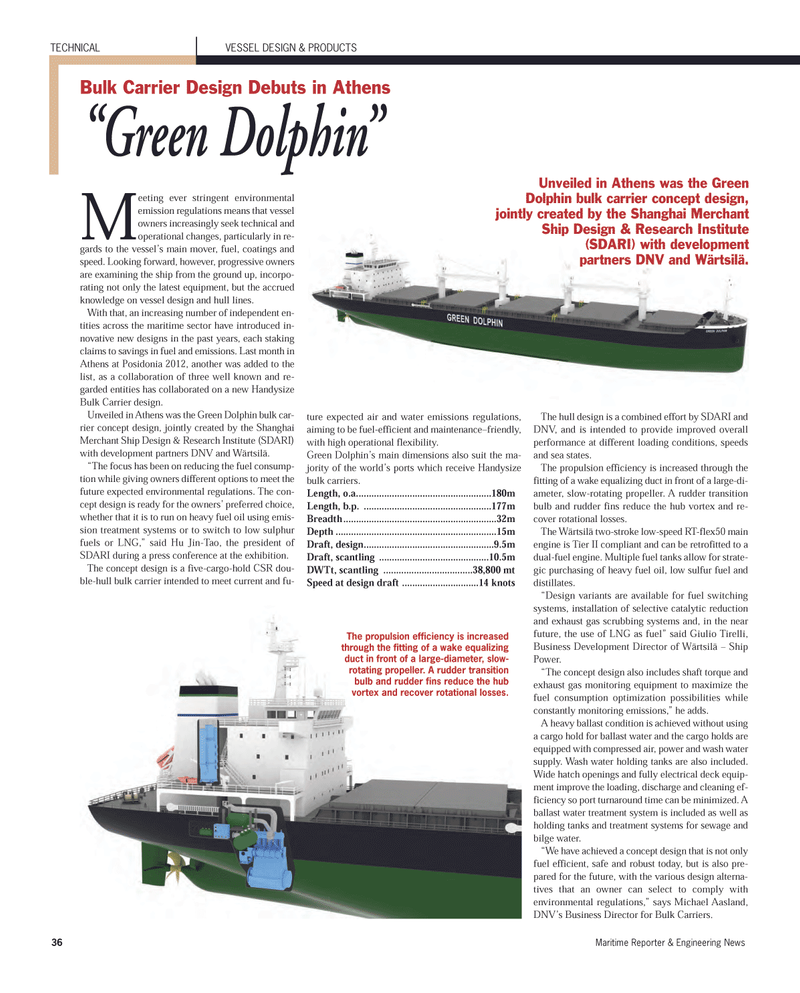
Page 36: of Maritime Reporter Magazine (July 2012)
Arctic Operations
Read this page in Pdf, Flash or Html5 edition of July 2012 Maritime Reporter Magazine
36Maritime Reporter & Engineering News Meeting ever stringent environmental emission regulations means that vessel owners increasingly seek technical and operational changes, particularly in re-gards to the vessel?s main mover, fuel, coatings and speed. Looking forward, however, progressive owners are examining the ship from the ground up, incorpo- rating not only the latest equipment, but the accrued knowledge on vessel design and hull lines. With that, an increasing number of independent en- tities across the maritime sector have introduced in- novative new designs in the past years, each staking claims to savings in fuel and emissions. Last month in Athens at Posidonia 2012, another was added to the list, as a collaboration of three well known and re- garded entities has collaborated on a new Handysize Bulk Carrier design.Unveiled in Athens was the Green Dolphin bulk car- rier concept design, jointly created by the ShanghaiMerchant Ship Design & Research Institute (SDARI) with development partners DNV and Wärtsilä. ?The focus has been on reducing the fuel consump-tion while giving owners different options to meet the future expected environmental regulations. The con- cept design is ready for the owners? preferred choice, whether that it is to run on heavy fuel oil using emis- sion treatment systems or to switch to low sulphur fuels or LNG,? said Hu Jin-Tao, the president of SDARI during a press conference at the exhibition. The concept design is a five-cargo-hold CSR dou- ble-hull bulk carrier intended to meet current and fu- ture expected air and water emissions regulations, aiming to be fuel-efficient and maintenance?friendly, with high operational flexibility. Green Dolphin?s main dimensions also suit the ma- jority of the world?s ports which receive Handysize bulk carriers. Length, o.a.....................................................180m Length, b.p. ..................................................177m Breadth............................................................32m Depth...............................................................15m Draft, design...................................................9.5m Draft, scantling ...........................................10.5m DWTt, scantling ...................................38,800 mt Speed at design draft ..............................14 knots The hull design is a combined effort by SDARI and DNV, and is intended to provide improved overall performance at different loading conditions, speeds and sea states. The propulsion efficiency is increased through the fitting of a wake equalizing duct in front of a large-di- ameter, slow-rotating propeller. A rudder transition bulb and rudder fins reduce the hub vortex and re- cover rotational losses. The Wärtsilä two-stroke low-speed RT-flex50 main engine is Tier II compliant and can be retrofitted to a dual-fuel engine. Multiple fuel tanks allow for strate- gic purchasing of heavy fuel oil, low sulfur fuel and distillates. ?Design variants are available for fuel switching systems, installation of selective catalytic reduction and exhaust gas scrubbing systems and, in the near future, the use of LNG as fuel? said Giulio Tirelli, Business Development Director of Wärtsilä ? Ship Power. ?The concept design also includes shaft torque andexhaust gas monitoring equipment to maximize the fuel consumption optimization possibilities whileconstantly monitoring emissions,? he adds. A heavy ballast condition is achieved without using a cargo hold for ballast water and the cargo holds are equipped with compressed air, power and wash water supply. Wash water holding tanks are also included. Wide hatch openings and fully electrical deck equip- ment improve the loading, discharge and cleaning ef- ficiency so port turnaround time can be minimized. A ballast water treatment system is included as well as holding tanks and treatment systems for sewage and bilge water. ?We have achieved a concept design that is not only fuel efficient, safe and robust today, but is also pre- pared for the future, with the various design alterna- tives that an owner can select to comply with environmental regulations,? says Michael Aasland, DNV?s Business Director for Bulk Carriers. TECHNICALVESSEL DESIGN & PRODUCTSBulk Carrier Design Debuts in Athens?Green Dolphin? Unveiled in Athens was the Green Dolphin bulk carrier concept design,jointly created by the Shanghai Merchant Ship Design & Research Institute (SDARI) with development partners DNV and Wärtsilä. The propulsion efficiency is increased through the fitting of a wake equalizing duct in front of a large-diameter, slow- rotating propeller. A rudder transition bulb and rudder fins reduce the hub vortex and recover rotational losses. MR#7 (34-41):MR Template 7/9/2012 2:57 PM Page 36

 35
35

 37
37
